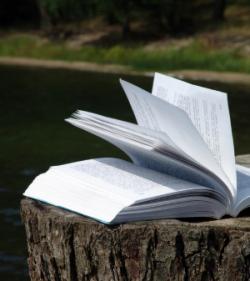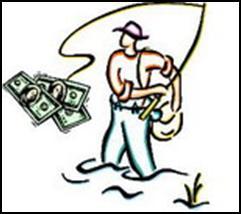Lake Shoreland Protection Resources
Clearinghouse for Information on Lakeshore Protection and Restoration
The U.S. Environmental Protection Agency’s 2010 National Lakes Assessment found that lakes with poor lakeshore habitat are three times more likely to be in poor overall biological condition than lakes with good quality shorelands. Scientists looked at the amount and type of lakeshore vegetation, such as grasses, shrubs, and trees, in making their assessment of lakeshore habitat conditions. This shoreland vegetation protects the lake from the effects of polluted runoff, stabilizes the soil along the lake’s edge, and provides habitat, shelter, food, and cooling shade for fish.
But a natural lakeshore does more than help the water quality of the lake and the quality of the its habitat; it helps the value of property along the lake, and it’s good business. Lakefront property generates millions of dollars in revenue. Studies show that when water clarity decreases, so do lake property values. Increasing development pressures are putting our lakes in peril. Many lakeshore property owners unknowingly harm their lakes by replacing natural lakeshore vegetation with lawns, clearing out submerged logs and branches at the water's edge, cutting down trees to get a better view, importing sand to make artificial beaches, building docks, and "armoring" the shoreland with concrete or wooden bulkheads.
This resources page provides practitioners links to key resources to protect and restore fragile lake shorelands and to promote better lakeshore stewardship by property owners.
For more information about lake shoreland restoration and/or protection, contact Anne Weinberg (weinberg.anne@epa.gov).
On this page:
- Lake Shoreland Protection Resources
- Featured News and Resources
- EPA Lakeshore Outreach Products
- Lakeshore Management Education Products
- Landscaping, Lawn Care, Native Plants, and Rain Gardens
- Social Marketing Resources
- State Lake Protection Programs
- Model Ordinances and Laws for Lakeshore Protection
- Lakes Meetings and Training Calendar
- Funding
- Multi-Media Resources
- Social Media
- Other Lakeshore Information
You may need a PDF reader to view some of the files on this page. See EPA’s About PDF page to learn more.
Lake Shoreland Protection Resources
- Featured News and Resources
- EPA Lakeshore Outreach Products
- Lakeshore Management Education Products (Fact Sheets, Guides, Manuals, Reports, Newsletters, Pamphlets, Brochures, Books, and Articles)
- State Lake Protection Programs
- Model Ordinances and Laws for Lake Shoreland Protection
- Lakes Meetings and Training Calendar
- Funding
- Multi Media Resources
- Social Media Resources
- Other Lakeshore Information
Featured News and Resources
The following links exit the site Exit
EPA Lakeshore Outreach Products
Use the Lakes Awareness Publications Order Form to request these items:
- Learning About Lakefront Property
- Healthy Lakes & Higher Property Values Factsheet
- Open the Door to Clean Lakes!
- Clean Lakes Need Healthy Lakeshores; Healthy Lakeshores Need You
Lakeshore Management Education Products (Guides, Fact Sheets, Manuals, Reports, Newsletters, Pamphlets, Brochures, Books, and Articles)
Lakeshore Management Information for Property Owners
Guides
The following links exit the site Exit
- Shoreline Stabilization Guidelines (PDF)(18 pp, 1.8 MB) — Reston Association. Comparison Matrix for Shoreline Stablization Methods (page 4).
- Shoreland Property: A Guide to Environmentally Sound Ownership (PDF)(11 pp, 1.6 MB) — Southeast Wisconsin Fox River Basin Partnership Team, University of Wisconsin–Extension, and Wisconsin Department of Natural Resources
- Guide to Lake Protection and Management (PDF) (xx pp, yy K) — Minnesota Pollution Control Agency. The Guide to Lake Protection and Management is a second edition of the Citizen's Guide to Lake Protection. This document contains updated and new material on the following topics: chemistry of lakes, watershed information, exotic species, altering runoff and lake use practices, development of a lake management plan, and nonstructural best management practices.
- Owning Waterfront Property: A Checklist Wisconsin Environmental Initiative (PDF)(2 pp, 308 K) — Tips and resources to assist landowners in adopting landscaping, lawn care, and building or remodeling practices that will preserve shoreland habitats (2003).
- A Guide to Aquatic Plants: Identification & Management — Shoreland Management, Minnesota Department of Natural Resources
- Minnesota Shoreland Management Resource Guide
- The Water's Edge: Helping Fish and Wildlife on Your Lakeshore Property (PDF)(12 pp, 630 K) — Division of Fisheries, Minnesota Department of Natural Resources (2009)
- Managing the Water's Edge: Making Natural Connections (PDF)(24 pp, 8.6 MB) — Southeastern Wisconsin Regional Planning Commission (May 2010) - This document provides important and up-to-date information and concepts related to riparian buffers in order to help protect and restore water quality, wildlife, recreational opportunities, and scenic beauty.
- Designing Shoreland Stewardship Packets: A Guide for Wisconsin Lake Organizations (PDF)(32 pp, 1.4 MB) — Wisconsin Association of Lakes (June 2007)
- Representing Property with Wetlands and Riparian Areas: A Guide for Montana's Realtors (PDF)(16 pp, 889 K) — Prepared by Montana Watercourse.
Fact Sheets
The following links exit the site Exit
- Lake Notes Fact Sheets — Illinois Environmental Protection Agency
- Best Management Practices for Lakes — Department of Ecology, State of Washington
- Protecting Your Waterfront Investment: 10 Simple Shoreland Stewardship Practices (PDF)(11 pp, 3 MB) — University of Wisconsin-Extension Center for Land Use Education Healthy watersheds make healthy lakes and higher property values — this booklet show how property owners can take simple steps to curb pollutants, cut runoff, and capture and cleanse pollutant-carrying runoff before it reaches a waterway.
- NALMS Lake and Reservoir Management Brochure — North American Lake Management Society Journal
- Lake Protection Series - Water Quality Division, Vermont Department of Environmental Control. Lakeshores are a limited and valuable resource, both to landowners as well as Vermont's native plants and animals. Learn how to live on a lakeshore, enjoy it, and protect the lake environment at the same by reviewing the fact sheets below.
- Introduction to the Lake Protection Series (PDF)(2 pp, 1 MB)
- Only You Can Save Your Lake (PDF)(2 pp, 285 K)
- Stabilization Measures for an Eroding Lakeshore (PDF)(3 pp, 1.3 MB)
- Conducting a Survey of a Lake Watershed (PDF)(2 pp, 1 MB)
- Lake Classification Fact Sheet Series — University of Wisconsin Cooperative Extension (UWEX)
- The Value of Good Water Quality and Shoreland Management (PDF)(2 pp, 2 MB)
- Shore Buffer Areas — "Woodsmen Spare That Tree" (PDF)(2 pp, 1 MB)
- Shallow Areas, The Near Shore Zone and Human Impacts (PDF)(2 pp, 1.2 MB)
- Lakeshore Development — It All Adds Up! (PDF)(2 pp, 2.5 MB)
- Guiding Lakeshore Development: Conservancy Development (PDF)(2 pp, 141 K)
- Looking Beyond the Lakeshore: Watershed Management (PDF)(2 pp, 905 K)
- Habitat Management and Natural Beauty Protection (PDF)(2 pp, 131 K)
- Shoreland Zoning and Water Quality Protection (PDF)(2 pp, 1.2MB)
Articles
The following links exit the site Exit
- The Art of Lakescaping (PDF)(3 pp, 463 K) — Lauren J. Bryant, Indiana University
- Lakeshore Property Values & Water Quality: Evidence from Property Sales in the Mississippi Headwaters Region Mississippi Headwaters Board and Bemidji State University (PDF)(59 pp, 166 K)
- Chapter Four - Shoreline Management - Washington State Department of Ecology
Books
The following links exit the site Exit
- Landscaping at the Water's Edge: An Ecological Approach — This book authored by University of New Hampshire's Cooperative Extension for landowners and landscapers explains how our landscaping choices impact surface and ground waters and demonstrates how, with simple observations, ecologically-based design and low impact maintenance practices, you can protect, and even improve, the quality of our water resources.
- Lakescaping for Wildlife and Water Quality — This book represents six years of research and the collaborative efforts of Carrol Henderson, DNR non-game wildlife specialist, Carolyn Dindorf, award-winning soil and water conservationist, and Fred Rozumalski, highly acclaimed landscape ecologist. Learn techniques to prevent lakeshore erosion, restore wildlife habitat, wildflowers, and clean water.
Landscaping, Lawn Care, Native Plants and Rain Gardens
The following links exit the site Exit
- EPA GreenScapes
- The Low Impact Development Center, Inc.
- Florida-Friendly Landscaping: The Smart Way to Grow
- Lady Bird Johnson Wildflower Center - The University of Texas at Austin
- Lake Protection Series - Water Quality Division, Vermont Department of Environmental Control
- Don't "P" on Your Lawn: Tips for green lawns not green lakes (PDF)(2 pp, 116 K)
- Go Wild! Plants and Plantings on a Lakeshore (PDF)(11 pp, 3.7 MB)
- Rain Gardens for Home Landscapes - Clean Water Campaign (PDF)(2 pp, 284 K)
- Rain Garden Design and Construction (PDF)(22 pp, 3.3 MB)
- How to Build a Rain Garden (PDF)(2 pp, 1 MB) - Dane County, Wisconsin Office of Lakes and Watersheds
- Wisconsin Department of Natural Resources
- Rain Gardens - Environmental Protection Agency (EPA)
- Online Native Plant Center for the Chesapeake Bay Region - Alliance for the Chesapeake Bay
Social Marketing Resources
The following links exit the site Exit
- University of Wisconsin Extension Environmental Communication and Social Marketing Newsletter
- Maine's LakeSmart Program
State Lake Protection Programs
The following links exit the site Exit
- Illinois Environmental Protection Agency Lake Education Assistance Program
- Minnesota Department of Natural Resources Lake Related Programs
- Oklahoma Water Quality Division Blue Thumb Program
- Vermont Water Qualilty Division Lakes Program
- Washington Department of Ecology Lake Information
- Wisconsin Lakes
Model Ordinances and Laws for Lakeshore Protection
Local/County Ordinances
- Urban Runoff: Model Ordinances to Prevent and Control Nonpoint Source Pollution
- Crafting a Lake Protection Ordinance From Urban Lake Management, Watershed Protection Techniques 3(4) (PDF) Exit(18 pp, 832 KB) — This article is part of an issue devoted to exploring how development impacts lakes and reservoirs, and examining ways to reduce these impacts with watershed management practices.
- Chapter 1000: Guidelines for Municipal Shoreland Zoning Ordinances Exit — Code of Maine Rules, Department of Environmental Protection - Shoreland Zoning Ordinance (May 2010)
State Laws
The following links exit the site Exit
- A Handbook for Shoreland Owners — Maine Bureau of Land & Water Quality - Shoreland Zoning
- Chapter 6120, Shoreland and Floodplain Management — Administrative Rules, Minnesota Department of Natural Resources
- Comprehensive Shoreland Protection Act Standards (RSA 483-B) — New Hampshire Department of Environmental Protection
- Wisconsin Department of Natural Resources
- Wisconsin Administrative Code, Chapter NR 115 (PDF)(7 pp, 62 K) — Wisconsin Shoreland Management Program
- Wisconsin Administrative Code, Chapter NR 116 (PDF)(15 pp, 128 K) — Wisconsin Floodplain Management Program
Lakes Meetings and Training Calendar
Funding
Multi-Media Resources
The following links exit the site Exit
- Margin of Error? Human Influence on Wisconsin Shores — Wisconsin Department of Natural Resources
- Growing Communities - Greening Communities: Managing Wisconsin’s Shorelands - Distance education workshop offered by UW-Extension for local officials (Fee Based)
Webcasts
Videos
The following links exit the site Exit
- Reston Lakes: Protecting America’s Lake Shorelines (on EPA’s YouTube Channel)
- "Talking Frog Video" developed by Bret Shaw, Assistant Professor at University of Wisconsin-Madison and University of Wisconsin Extenstion
- "Sebastian the Goose" video developed by Bret Shaw and Larry Meiller
- Neighbor-to-Neighbor Florida Friendly Landscaping: Waterfront
- "Keeping Our Shores: Shoreland Best Management Practices"- University of Minnesota
- "The Living Shore: Best Management Practice for Shoreland Vegetation" - University of Minnesota
- "Shoreland Restoration: A Growing Solution" - University of Minnesota
- Reduce Runoff: Slow It Down, Spread It Out, Soak It In — The U.S. EPA and the U.S. Botanic Garden produced this 9-minute on-line video that highlights green techniques such as rain gardens, green roofs, and rain barrels to help manage stormwater runoff.
Social Media
The following links exit the site Exit
- EPA's Water is Worth It
- American Sportfishing Association
- North American Lake Management Society (NALMS)
- Salt Lake Conservation District
Blogs
- Wisconsin Department of Natural Resources Lakes-L Blog
- ECHO Lake Aquarium and Science Center/Leahy Center for Lake Champlain
